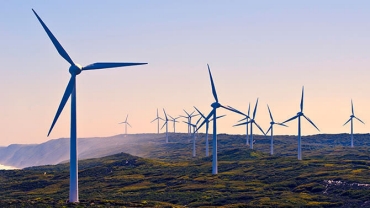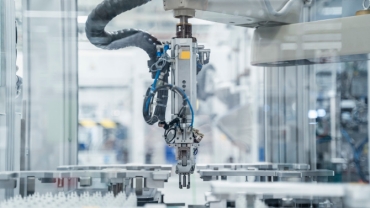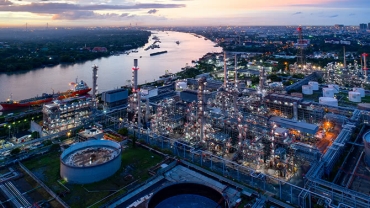
Interview: “The Fit for 55 package requires quick and interdisciplinary action”
20 January, 2022
An interview with Folker Trepte, Dr Volker Fitzner and Dr Klaus-Peter Gushurst. Europe is considered a global pioneer in the field of climate protection and, with the European Green Deal, is striving for climate neutrality by 2050. One milestone that the European Union has set itself is to reduce CO2 emissions by 55 percent by 2030 compared to 1990.
Fit for 55 is the European Commission’s far-reaching package of measures for achieving its ambitious climate goals. Folker Trepte, Energy, Utility & Resources Leader Germany, Volker Fitzner, PwC Global Leader Chemicals, and Klaus-Peter Gushurst, Head of Industries & Innovation at PwC Germany, explain how the project is forcing various sectors to act, but can also offer opportunities for sustainable economic growth.

Focus: Energy sector
Mr Trepte, the EU Commission’s ambitious Fit for 55 package poses particular challenges for the energy industry, which is the most CO2-intensive sector. Which guidelines or measures are particularly significant?
Folker Trepte: With regard to the CO2 intensity of the energy industry, the focus is of course on the continued limitation and reduction of freely allocated emission certificates in EU emissions trading. The further increase in the price of emission allowances will put even more pressure on companies to decarbonise faster.
But the EU directive for renewable energies also calls for quick and effective action: the target share of renewable energies by 2030 is to be increased by eight percentage points to 40%.
The new federal government’s coalition agreement sets an even more ambitious target for the share of renewable energy, namely 80 %.
For this we need extensive investments in solar photovoltaic systems, wind farms and hydrogen.
What does this mean specifically for energy suppliers’ existing business models?
Trepte: Companies with business models that are currently heavily based on fossil fuels will come under pressure from the targeted reduction in emissions of 55% by 2030.
Couldn’t that also be an opportunity?
Trepte: Definitely! The Fit for 55 package offers energy suppliers the opportunity to generate growth and secure market shares by gearing their business model towards renewable energies at an early stage.
While energy suppliers have to question their existing business models and rethink them, they have the opportunity to align themselves with long-term trends and market requirements. In the coming decade, traditional barriers between different energy sectors such as oil and gas, power utilities and chemicals will disappear and integrated energy systems will emerge.
What does that mean for energy suppliers in concrete terms?
Trepte: All companies will now have to take quick decisions in order to make renewable energy available within the required framework. After all, one of energy suppliers’ most crucial tasks is to ensure supply security.
What will be the decisive factors?
Trepte: In order to help achieve the climate goals, companies must now open up new business areas and make massive investments in renewable energies.
Companies’ future competitiveness depends crucially on their ability to think ahead and adapt their business models in the light of the emerging new energy systems.
Focus: Industrial production
Dr Klaus-Peter Gushurst, you’re in charge of the German network for industrial production at PwC. How do you assess the impact of the Fit for 55 package on the manufacturing industry?
Klaus-Peter Gushurst: With its high resource intensity and global value chains, industrial manufacturing has a particular responsibility when it comes to climate protection, but it also has particularly large levers for making the future of manufacturing more sustainable and ecological. The high energy consumption of heavy industries and the decreasing number of emission allowances will send the ETS price skyrocketing and make our dependence on renewable energies even greater.
The priority should therefore be to spread and deploy low-carbon technologies in the industry as quickly as possible while remaining internationally competitive.
What concrete contribution can the industrial sector make?
Gushurst: By mobilising its innovative strength, it can help bolster German exports with sustainably produced industrial goods and technologies. In addition to the necessary funding measures for innovations and technologies, such as green steel, there are numerous creative avenues of opportunity for manufacturing companies to actively promote sustainable solutions along their value chain.
How can the transition to a carbon-free industry succeed?
Gushurst: To decarbonise their power, heating and cooling consumption, manufacturers should focus on efficiency gains, industrial symbiosis, electrification and green gases. Sustainable supply chains and the principle of the circular economy will play a major role in not only reducing the ecological footprint of these companies, but also saving costs at the same time.
Today we can already foresee that renewable energy generation capacities in 2030 will not be sufficient to cover the manufacturing industry’s consumption in Germany. How can manufacturers secure the supply of green energy to their production facilities?
Gushurst: Industrial manufacturing has a range of options for meeting its demand for electricity from renewable energy sources.
Power Purchase Agreements (PPAs) are becoming increasingly recognised as a proven method for long-term power procurement.
However, these are subject to weather-related fluctuations in supply, which can either be controlled at portfolio level or secured by a contractually agreed base load supply.
What alternatives are there?
Gushurst: Brown- and greenfield investments offer the most independence for energy procurement, but they require infrastructural expertise, project development capacities and the corresponding resources.
Industry giants such as BASF are already taking this route: the group is acquiring 49.5 % of the Hollandse Kust Zuid (HKZ) wind farm from Vattenfall with the aim of securing the long-term supply of its nearby production site with offshore wind energy.
Focus: Chemical industry
Dr Fitzner, you’re in charge of the global chemicals network at PwC. What impact is Fit for 55 going to have on the chemical industry?
Volker Fitzner: The historically close cooperation between the oil and gas industries in the petrochemical sector is now being actively extended to the energy and supply sector. The focus is on enabling reliable access to renewable energy in large quantities and at reasonable prices.
The electricity requirements of the chemical industry will triple or quadruple if chemical production is to become climate-neutral.
Value creation with an eye on ecological, economic and social impact is becoming the overarching management principle for companies, suppliers and customers in the chemical industry.
How can sustainable growth be achieved in such a situation?
Fitzner: Intelligent use of resources is certainly important. In order for this ecological transformation to work competitively and at high speed, additional government measures are needed that not only enable, but actively promote the rapid expansion of renewable energies and the associated transport infrastructure. New business models will emerge on that basis.
How should chemical companies act in view of this?
Fitzner: In order to be successful in the changing competitive landscape, chemical companies should pursue a clear, innovation-driven ESG strategy.
Innovations will range from product and service innovations to the emergence of new business models that enable sustainable growth.
Chemical companies have a great opportunity here to develop into role models of the circular economy.
Can you give examples?
Fitzner: Leading German and foreign chemical companies are moving in this direction in a structured and focused manner. For example, that is happening in the area of battery materials. Success will also depend on whether collaboration with external partners upstream and downstream in this new value chain works efficiently.
What challenges can you foresee?
Fitzner: The significant changes in the use of resources and, downstream, the alignment with the rapidly changing requirements of customer industries will require much more sophisticated scenario planning that is also able to take disruptive developments into account. In this context, companies’ decision-making and business processes will also need to be realigned.
More interviews
“To be fit for the future, companies must pay more attention to ESG factors”
An interview with Petra Justenhoven and Nicolette Behncke: Sustainability is becoming increasingly important for companies’ internal management and external reporting. What does this mean for companies and how should they adapt to it?











